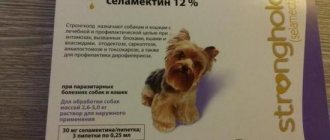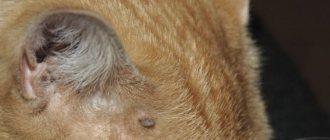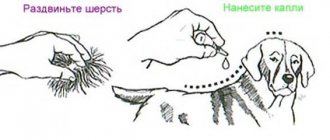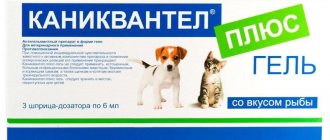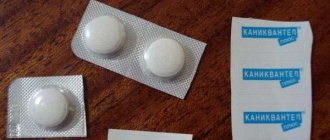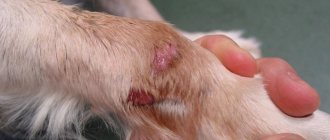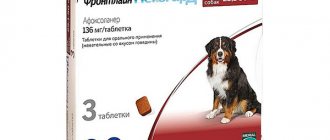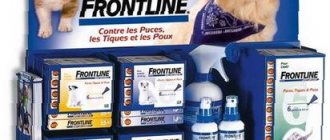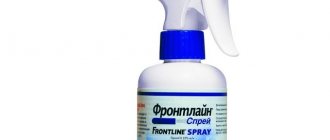Skin parasites of cats
The most common and common in cats are:
- Fleas choose not only animals as victims, but also humans. Insects actively jump on the animal's skin and are easy to notice. More than 60 species of blood-sucking parasites carry over 200 diseases: anthrax, typhoid fever, salmonellosis, helminthiasis, and various fungal infections. Adult fleas do not live on the victim's body 24 hours a day. Having had enough, they leave the cat.
- Lice eaters are small wingless insects. They feed on particles of fur and epidermis, and blood. Like other ectoparasites, lice eaters force the cat to constantly scratch the skin until wounds appear. Damaged skin is easily attacked by pathogenic bacteria. When a cat is infected with a lice-eater, sleep and appetite are disrupted, immunity decreases, and allergies occur.
- Lice - when infested with lice, the animal behaves restlessly, scratches the skin, and loses hair. Lice are easy to spot. On your pet's light coat, black dots that look like dirt and dust are clearly visible - these are parasite excrement. In case of mass infection, the animal faces dermatitis and complete baldness. Lice are carried by helminth larvae.
- Ixodid ticks - attack cats in the warm season. These small insects feed on blood and grow greatly in size. A swollen tick can be noticed immediately. A cat's skin and fur are very sensitive, so the animal can easily shake off an unattached tick from its skin. In search of food, insects willingly move onto people. Ticks carry many diseases: viral encephalitis, typhus, tularemia, hemorrhagic fever, piroplasmosis, helminthiasis, etc.
- Scabies mites live on the skin of a cat, gnawing passages in the inner layer of the dermis. They feed on epithelial cells and lymph. From a sick animal the tick is transmitted to people.
- Sarcoptoid mites are the cause of scabies. The peculiarity of this form is the rapid baldness of the ears, belly and muzzle.
- Ear mites - attack the animal's hearing system. The cat shakes its head and tries to get its hind paw inside the ear. Dark brown crusts form in the ears, followed by pus. Without treatment, the parasites gradually penetrate through the inner ear into the brain, and the animal dies.
- Heartworms (dirofilaria) cause one of the most dangerous diseases, dirofilariasis. The helminth larvae enter the mouthparts of the mosquito with the blood of the infected creature, and with the next bite the parasites enter the body of the final victim. They live under the skin, in the muscles of internal organs. Parasites destroy the heart, lungs, and coronary vessels. Without treatment, the animal faces death.
Photo gallery: dangerous cat ectoparasites
Fleas are the most common skin parasites
Hairworm - the cause of focal baldness in cats
Cat lice are as common as fleas, although they are less well known.
Hungry and well-fed ticks are very different in appearance
Getting rid of ear mites is a long and expensive task.
Heartworm is the causative agent of dirofilariasis, spread by mosquitoes.
Composition and release form of the drug Frontline
To combat skin parasites of cats, the French corporation Merial SAS created the drug Frontline. The company conducts serious research and has a strong reputation in the market for manufacturers of veterinary drugs.
The drug is available in three dosage forms:
- drops in polyethylene pipette bottles with a volume of 0.5 to 4.02 ml;
- spray in bottles with a sprayer of 100, 250 and 500 ml;
- Chewable tablets (for dogs only)
Table: dosage forms for cats
| Name | Dosage form | Volume, ml | Included | |
| active substance | Excipients | |||
| Frontline Spot On | drops on the withers |
| fipronil |
|
| Frontline Combo | drops on the withers |
|
|
|
| Frontline Spray | spray |
| fipronil |
|
Photo gallery: release forms
Frontline spray with a volume of 100 and 250 ml is most convenient for home use
Drops for the withers Frontline Spot It are available in a dropper bottle with detailed instructions
Frontline combo acts not only on adult parasites, but also on their eggs and larvae
Frontline Nexgard meat-flavored chewable tablets are for use only in dogs.
Active ingredients of the veterinary drug Frontline:
- Fipronil has a detrimental effect on the central nervous system of parasites, disrupting the movement of nerve impulses. Causes paralysis and subsequent death of insects. Fipronil does not have a systemic effect on the body of a pet, destroying only pests.
- S-methoprene (as part of Frontline Combo) is an analogue of the hormone-regulator of insect growth, causes developmental anomalies at the egg and larval stages, prevents the appearance of adult individuals on animals and in places where they are kept.
Additionally, Frontline contains excipients:
- in the spray - isopropanol, copolyvidone, purified water, polysorbate;
- in drops on the withers - butylated hydroxyanisole, butylhydrotoluene, diethylene glycol, polyvidone, polysorbate.
The content of the active substance in any form ensures effective destruction of parasites.
Prices for Frontline for cats and kittens
The cost of the drug is determined by the shape and size of the container. Fluctuations in price in different regions of the country and in different pharmacies are insignificant. One 0.5 ml Frontline Spot On pipette costs about 400-500 rubles. The price of the flea and tick drug Frontline Combo varies approximately within the same limits.
Frontline spray costs an order of magnitude more than drops. The price for a bottle with a minimum volume (100 ml) ranges from 1000 to 1300 rubles. A medium-packed drug (250 ml) costs 1500-1800 rubles. The most expensive is a large bottle (500 ml). Its price reaches 2600 rubles.
Mechanism of action
After use, the active substance does not penetrate into the blood, but is distributed throughout the skin and hair. The drug has a contact effect - parasites die when they come into contact with Frontline microparticles. After the product gets on the skin, the active agents fipronil and S-methoprene, together with sebum, are distributed over the surface, enveloping the hairs and covering every millimeter of the cat’s body with an invisible veil.
Frontline acts contactally, destroying only parasites
How to use Frontline correctly - treatment algorithm
Before treatment, it is recommended to weigh the cat, determine the required dose, comb the cat’s fur, and remove all tangles. The pet's skin must be completely dry, undamaged, without open wounds or visible scratches at the site of application. For cats, the drug Frontline is used in 0.5 ml applicators.
The procedure for treating a cat with drops on the withers at home:
- Wear protective gloves.
- Remove the dropper bottle from the packaging, move the drug into the wide part of the bottle using tapping movements, and unscrew the tip of the dropper.
- Spread the fur at the withers, exposing the skin at the junction of the cervical spine and the thoracic spine (on the shoulder blades).
- Squeeze the pipette and apply a few drops of the solution in a heap, in a checkerboard pattern.
- Distribute the preparation over the skin, running your hand several times against and along the growth of the fur.
Video: how to treat a cat for fleas using drops
Remember! Drops are applied pointwise in a checkerboard pattern to the area between the shoulder blades (at the withers).
To get rid of ear mites, 4-6 drops are injected into each ear canal. To distribute the drug evenly, the ear is closed and easily kneaded. The remaining drops in the pipette bottle can be applied to the withers.
Remember! For 2 days after treatment, protect the cat’s fur from moisture, do not bathe or use other drugs against skin parasites.
The procedure for self-treating a cat with Frontline spray:
- Processing should be done outdoors or in a well-ventilated area.
- Wear protective gloves and respiratory protection.
- Fasten the pet's protective neck collar and secure its jaws until the preparation dries completely on the fur.
- Fluff the cat's fur against the natural hair growth.
- Shake the bottle thoroughly.
- Holding the spray can upward at a distance of 10–20 cm from the cat, press the head of the aerosol can.
- Treat your pet until the fur is moistened, starting from the tail: back, belly, limbs.
- To treat the face, groin and armpits, apply the product to the glove and rub into the fur, avoiding contact with the eyes and mucous membranes.
- Brush the fur with a wide-toothed brush to get the product onto the skin.
The drug consumption is 3 ml per 1 kg of weight for short-haired cats and 6 ml for long-haired cats. The product is convenient to dose: one press removes a 0.5 ml dose of Frontline from a 100 ml bottle.
Typically required for cats weighing:
- up to 5 kg - from 30 for short-haired to 60 clicks for long-haired animals;
- up to 10 kg - from 60 to 120 presses;
- up to 15 kg - from 90 to 180 presses.
A single treatment of a cat with Frontline kills parasites in 1–2 days. Barrier protection against ticks lasts for 4 weeks, against fleas, lice and lice for 6 weeks.
Video: how to treat your pet for skin parasites using a spray
Remember! Treat all animals in the house, change bedding or disinfect them, otherwise re-infection is possible.
I recently got a new cat. A foundling, like all my animals. The poor guy jumped out onto the road opposite the dacha cooperative. It was at the end of autumn, with the onset of the first cold weather. The unfortunate animal was on the verge of death. I took him home. The cat was so scared and exhausted that I decided to give him time to recover from the stress. He went to the vet 3 days later. Upon examination, all possible parasites were discovered: worms, fleas and ear mites. The cat was prescribed treatment. The doctor advised to wait 5 days and treat for fleas and helminths. While the waiting period was passing, the other cat also began to itch, although the animals had almost no contact. During the second visit, the veterinarian recommended treating the cat with Frontline Combo anti-flea drops on the withers once, and treating the cat with Frontline Spot On drops twice according to the scheme. And he focused on replacing or disinfecting bed mats. I didn’t even think about changing the bedding! There was no need to wear any collars, and there was no aggressive smell; both pets tolerated the procedure well. An easy and simple solution, and the fleas were defeated. I noted for myself the importance of regular flea treatment. Parasite eggs can be brought in from the street on the soles of shoes. And then the infection will occur again.
Frontline Spray
Instructions #
on veterinary use of the drug Frontline Spray
(Developer organization: Boehringer Ingelheim Animal Health France SCS, 29 avenue Tony Garnier, 69007, Lyon, France / Boehringer Ingelheim Animal Health France SCS, 29 avenue Topu Garnier, 69007, Lyon, France)
I. General information
1. Trade name of the medicinal product: Frontline Spray. International nonproprietary name: fipronil. 2. Dosage form: solution for external use. Frontline Spray 100 ml contains fipronil as an active ingredient - 0.25 g, as well as excipients: copovidone, isopropanol and purified water. 3. In appearance, the drug is a colorless transparent liquid. The shelf life of the medicinal product, subject to storage conditions, is 3 years from the date of manufacture. The shelf life of the drug after the first opening of the bottle is 3 years. It is prohibited to use the medicine after the expiration date. 4. Frontline Spray is produced packaged in 100 and 250 ml in polyethylene bottles of appropriate capacity with a spray head. Each consumer package is supplied with instructions for use. 5. Store the medicinal product in the manufacturer’s sealed packaging, separately from food and feed, in a place protected from direct sunlight, away from heating devices and fire sources, at a temperature from 0 °C to 30 °C. 6. Frontline Spray should be kept out of the reach of children. 7. Unused medicinal product is disposed of in accordance with legal requirements. 8. Frontline Spray is available without a veterinarian's prescription.
II. Pharmacological properties
9. Frontline Spray is a contact-acting insectoacaricidal drug. 10. Fipronil is an insectoacaricide of the phenylpyrazoles group, the mechanism of its contact action is to block GABA-dependent arthropod receptors, disrupt the transmission of nerve impulses, which leads to paralysis and death of ectoparasites. Frontline Spray is active against:
- sexually mature stages of development of fleas Ctenocephalides spp.;
- lice eaters Trichodectes canis, Felicola subrostratus;
- ixodid ticks (all developmental phases) Rhipicephalus sanguineus, Dermacentor variabilis, Ambluoma amaicanum, lxodes holocyclus, lxodes scapularis, lxodes ricinus, Haemaphysalis spp. including Haemaphysalis longicornis, Haemaphysalis jlava, Haemaphysalis campanulata, Haemaphysalis leachi;
- sarcoptoid mites Sarcoptes scabiei var. canis;
- mosquitoes Aedes aegypti.
After applying the drug to the skin and hair, fipronil is practically not absorbed into the systemic bloodstream, accumulates in wool, epidermis, hair follicles and sebaceous glands, has a long-term contact insectoacaricidal effect, and also prevents the development of ectoparasites on animals. A single treatment of the animal ensures the destruction of fleas and ticks within 24 and 48 hours, respectively. The protective effect of the drug after treating dogs against ticks lasts up to 5 weeks, against fleas 4-12 weeks; after treating cats against ticks for up to 4 weeks, against fleas for up to 6 weeks. Frontline Spray, in terms of the degree of impact on the body, belongs to moderately hazardous substances (hazard class 3 according to GOST 12.1.007-76), in recommended doses it does not have skin-irritating and resorptive-toxic, embryotropic and teratogenic effects, if it gets into the eyes it causes mild irritation . The drug is toxic to rabbits, bees, as well as fish and other aquatic organisms.
III. Application procedure
11. Frontline Spray is prescribed to dogs and cats for the treatment and prevention of entomosis caused by fleas, lice and lice; acaroses caused by ixodid and sarcoptoid ticks; in complex therapy of allergic dermatitis caused by fleas. 12. Contraindication for use is the animal’s individual hypersensitivity to the components of the drug (including a history of it). The use of the drug is prohibited for patients with infectious diseases, convalescent and weakened animals, as well as puppies and kittens under 2 days of age. 13. When working with a medicinal product, you should follow the general rules of personal hygiene and safety precautions provided for when working with medicinal products for veterinary use. When carrying out therapeutic and preventive measures using Frontline Spray, it is recommended to use rubber gloves. Smoking, drinking and eating are prohibited during work. After working with the medicinal product, you should wash your hands with soap and wash and dry your gloves. Within 24 hours after treatment (until the fur is completely dry), you should not pet or allow the treated animal near small children. People with hypersensitivity to the components of the drug should avoid direct contact with the drug. If the drug accidentally comes into contact with the skin, it must be washed off immediately with soap and water; In case of contact with eyes, rinse them for several minutes with running water. If allergic reactions occur and/or if the drug accidentally enters the human body, you should immediately contact a medical facility (bring the instructions for use or label with you). It is prohibited to use empty drug bottles for household purposes. They are placed in a plastic bag and disposed of with household waste. 14. Frontline Spray can be used to treat breeding animals, pregnant and lactating females. 15. Treatment of animals is carried out in the open air or in a well-ventilated room with open windows (vents), having previously covered the aquarium with fish. To prevent licking of the drug, the animal is put on a muzzle or cervical collar, which is removed after the fur has completely dried. Before use, shake the bottle with the drug thoroughly and, holding it vertically, press the spray head and direct it onto the surface to be treated from a distance of 10-20 cm. The dose of the drug, depending on the length of the coat, is 3-6 ml. per 1 kg of animal weight. One press on the spray head of a 100 ml bottle provides a dose of 0.5 ml; One press on the spray head of the 250 ml bottle provides a dose of 1.5 ml. The spray is applied to the entire body of the animal against hair growth, slightly moistening the fur (in animals of long-haired breeds, the hair is lifted by hand). Covering the animal's eyes, treat the ears and chest, and lightly rub the drug around the eyes and nose with your fingertips. In order to prevent re-infestation of animals with fleas, it is recommended to treat all cats and dogs living together, as well as replace bedding or treat them with an insecticidal agent in accordance with the instructions for its use. Repeated treatments of animals are carried out according to indications, but not more than once every 4 weeks. Within 24 hours after treatment (until the fur is completely dry), the treated animal should not be allowed near open fires or heating devices. Do not wash or bathe animals with detergents, do not allow animals into natural bodies of water for 48 hours after treatment, and also apply the drug to wet or damaged skin. 16. When using the drug in accordance with these instructions, side effects and complications in animals, as a rule, are not observed. In case of increased individual sensitivity and the occurrence of allergic reactions, the drug should be washed off with water and detergent and, if necessary, antihistamines should be prescribed. When licking the drug from the fur, increased salivation is possible. In rare cases, transient skin reactions such as erythema, itching or alopecia may occur. In exceptional cases, excessive salivation, reversible neurological symptoms (hyperesthesia, depression, nervous symptoms), vomiting or respiratory symptoms may occur after using the drug. 17. In case of an overdose, the animal may experience excessive salivation, muscle tremors, and vomiting. In this case, the drug is washed off with water and detergent, and the animal is prescribed antihistamines and symptomatic therapy. 18. Frontline Spray should not be used in combination with other insectoacaricidal agents for treating animals. 19. No specific effects of the drug upon its first use and discontinuation have been identified. 20. Violations of the recommended interval between treatments should be avoided, as this may lead to a decrease in the effectiveness of the drug. If the next treatment is missed, it should be carried out as soon as possible in the same dose. 21. Frontline Spray is not intended for use on food producing animals.
Names and addresses of production sites of the manufacturer of a medicinal product for veterinary use: Boehringer Ingelheim Animal Health France, 4 Chemin du Calquet, 31000 Toulouse, France / Boehringer Ingelheim Animal Health France, 4 Chemin du Calquet, 31000 Toulouse, France
Name, address of the organization authorized by the holder of the registration certificate of the medicinal product to accept claims from the consumer/Importer: Boehringer Ingelheim LLC, Russian Federation, 125171, Moscow, Leningradskoe Shosse, 16A, building 3 Tel.
Indications for use
Frontline is prescribed to cats:
- for the treatment and prevention of diseases caused by fleas, lice and lice, ixodid ticks;
- complex therapy of allergic dermatitis caused by fleas;
- to prevent the attachment and development of ectoparasites on animals.
Frontline Spot It repels mosquitoes and destroys:
- mature fleas;
- lice eaters;
- ixodid ticks (all phases of development);
- lice;
- scabies mites.
Frontline Combo also repels mosquitoes and destroys:
- fleas (mature and insects in the egg, larvae, and pupal stages);
- lice eaters;
- ixodid ticks (all phases of development);
- sarcoptoid mites.
Frontline Spray is used to destroy:
- mature fleas;
- lice eaters;
- ixodid ticks (all phases of development);
- lice.
Use of the product for kittens and pregnant cats
The drug does not have a toxic effect on the fetus and the growth of cubs, therefore it is successfully used in the treatment of kittens, pregnant and lactating cats.
Frontline protects both small kittens and nursing cats equally effectively
When treating a lactating cat, Frontline Spot On drops are better suited. Then there is no need to isolate the cubs or wait for the moisture to evaporate from the mother’s hair. Kittens over two days old can be treated with a spray. However, for such babies, the manual method of extermination will be simple and safe. In the delicate fur, tiny pests can be easily caught.
Biological properties
Fipronil, which is part of the drug, has a pronounced insecticidal and acaricidal effect against lice, fleas, lice and ixodid ticks parasitizing dogs and cats at all stages of development. When applied to the skin and hair, the drug is practically not absorbed through the skin, accumulates in the epidermis and sebaceous glands of the animal and has a contact insectoacaricidal effect on ectoparasites. Provides protection against insects for 3 months, and against ticks for 1 month after a single use. Low toxicity for warm-blooded animals, in recommended doses it does not have skin-resorptive, mutagenic, sensitizing, embryotoxic and teratogenic effects, the drug is well tolerated by dogs and cats at a therapeutic dose and 5 times higher than it. In case of contact with eyes, it causes mild irritation.
Contraindications and side effects from the drug Frontline
The product is not used:
- with hypersensitivity to the components of the drug;
- for infectious diseases;
- with decreased immunity after a recent illness;
- in the process of treating otodectosis (ear mites) when the integrity of the eardrum is damaged;
- in case of possible contact of the drug with the mucous membrane of the eyes, on wet or damaged skin.
When used according to the treatment regimen, the drug does not have any side effects. If the dose of a veterinary drug is exceeded, the animal may experience:
- salivation;
- vomit;
- rapid breathing.
If symptoms of overdose are pronounced, the cat should be shown to a veterinarian, the animal should be washed with hypoallergenic pet shampoo, and antihistamine therapy should be administered.
Remember! Strictly adhere to the regimen of using the drug, otherwise the effectiveness of killing parasites will decrease.
Approximate cost and existing analogues
In online stores the drug can be purchased at a price of 880 rubles. for a 100 ml spray bottle, Frontline Spot On drops - 460 rubles, Frontline Combo drops - 520 rubles. per dropper bottle.
Table: analogues of the drug Frontline
| Drug name | Release form | Country of Origin | What parasites does it protect against? | Active substance | Price, rub | Compared to the drug Frontline Spot On drops on the withers | |
| dignity | flaws | ||||||
| Stronghold | drops | USA |
| selamectin | 800 |
|
|
| Blokhnet |
| Russia |
| fipronil | 100 | significantly lower price | minimum drop volume 1 ml. |
| Fiprist |
| Slovenia |
| fipronil | 300 |
| shorter duration of action. |
| Leopard |
| Russia |
| fipronil | 70 |
| Contraindicated for pregnant and lactating cats. |
| Rolf | drops | Russia |
| fipronil; pyriproxyfen. | 200 | lower price |
|
| Advantage | drops | Germany |
| imidacloprid | 250 |
| less protection (not effective against ticks). |
How to distinguish from a fake
Since the drug Frontline is a popular remedy and is often recommended by veterinarians, fakes are sometimes found in pet pharmacies. To protect yourself from a useless purchase, it is worth knowing the distinctive features of the original. These include:
- A plastic container with drops is always packed in a sealed cardboard package;
- The Frontline logo is printed directly onto the dropper itself;
- The company name is printed on the packaging;
- The batch number and production date are duplicated on the applicator and cardboard base;
- Each copy is accompanied by a leaflet with detailed instructions for use;
- There are no additional holograms or stickers on the packaging;
- For Frontline spray and drops, the composition, concentration, and volume of the drug are indicated;
These external signs are classic. Merial periodically changes some design elements. The color of the packaging or the photo of the cat may change. Some blisters are marked “PCT”, which replaces the Soviet quality mark and means that the product meets the requirements of GOST certification.
